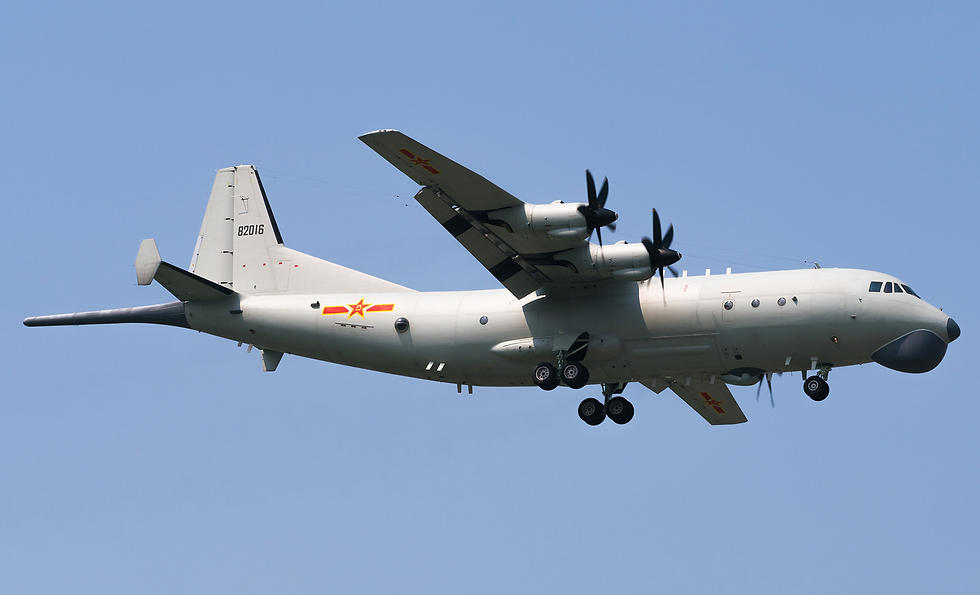The Antonov 12 – Russia’s Herc
- Garth Calitz
- May 1, 2024
- 5 min read
By Rob Russell
In the late 50’s, at the height of the Cold War, the USSR had identified a serious shortcoming in their logistical support – that being the ability to fly their military vehicles, as well as a troop carrier and being able to provide logistical support. It had a range of about 3500NM, which made it ideal for transporting anything around the Soviet Union.
The Antonov Design Bureau came up with several proposed models, It eventually settled on a large 4 engined high wing aircraft, powered by 4 turboprop aircraft. To NATO, it was given the designator - Cub. The prototype An-12 flew in December 1957 and entered Soviet military service in 1959. Initially, the aircraft was produced at the State Aviation Factory in Irkutsk. From 1962, production was transferred to Tashkent, where 830 were built. Later, production moved to Voronezh and Kazan.
Like all Soviet Union designed transport aircraft, it was built to operate into and from any strips, be they asphalt, grass, gravel or even snow. It came with its own APU and is thus self-supporting in all aspects. It was designed for harsh conditions as well and the aircraft could cope in sub-zero conditions as well as it could in humid tropical weather. There are still many models flying around the world today, it is a mark of respect for the strength and reliability of this aircraft. In earlier models, there was even a place for a tail gunner, although seldom used in anger, this was eventually removed, to increase range and payloads.
In terms of configuration, size, and capability, the aircraft is similar to the United States-built Lockheed C-130 Hercules. In fact, many people believe that the Antonov 12 was primarily designed to compete with the Herc, however with the addition of cranes and hoists, it was able to load bulk items much easier than its American competitor. Many people believe the Russians tried to copy the Herc, but many others believe that the Cub was based on the British Shorts Belfast, they being remarkably similar in size and design. The Belfast saw service in the RAF, where it proved to be a more than suitable large medium-range transport, eventually being replaced by the Herc. In military use, the An-12 has a capacity for up to 100 fully equipped troops or 20,000kg of cargo, which is loaded through the rear loading ramp/door
Many Russian designs looked remarkably similar to Western aircraft. There was no doubt that many Russian aircraft, designed during the Cold War, had their origins in the West. One only to look at the Tupolev 154, which bore a remarkable similarity to the Hawker Trident, as well as the Illusion 62, which looked very much like the VC10, to believe that the USSR had a very good spy network, operating especially around Europe and Great Britain, which had access to the design specs of the Western aircraft.
The most famous case, was where the Russians managed to get hold of the plans of the Concorde and build their version – the Tupolev 144. Their spy network had infiltrated right into the heart of the British Aircraft Corporation. However, the “Concordski” was never able to reach the level of service and reliability of its competitor.
Over time various models and variants evolved. Two notable variants were the electronic intelligence (elint) “Cub-A/B” and the ECM (electronic countermeasures) “Cub-C/D”. The “elint” variant differs by number and location of antenna fairings and blade aerials, varying from “carrot-type” fairings on the wing tips and tailfin to the large oval compartment protruding from the (former) tail turret.
An-12s have been spotted over the Baltic Sea fitted (for an Anti-Submarine role) with nose and tail sensor arrays. This variant, dubbed the “Cub-C”, features several additional air scoops and heat exchanger outlets. All internal electronic equipment is palletized and may be used in several configurations. The “Cub-D” is a second ECM platform, with different equipment fittings and characterized by huge external pods on the lower corners of the forward fuselage and each side of the base of the tailfin.
Several Air Forces ordered these “elint” variants, amongst them being the Indian Air Force. They were nicknamed “Himalayan geese” by the Indians.
Its most significant use was seen during the Afghan war, where without an aircraft of this size, the Russians would have been on the back foot. They provided a vital service carrying supplies and troops into Afghan bases and ferrying injured personnel back to Russia after the USSR was dissolved, there were many surplus aircraft about and many unscrupulous Companies and private operators saw this aircraft as an ideal aircraft to smuggle not only arms but anything available to be flown. Some of these aircraft were quite literally stolen, by serving Russian crews, from USSR bases and flown to the Middle East, where false registrations were painted and dubious companies sprung up, offering freight services to anyone, who was prepared to pay for them. Many of the Russian crews went on to operate these aircraft for years, almost living in the aircraft, for fear of someone else trying to steal them!
The rapid growth of bases and airfields around the Middle East – Ras Al Khaimah and Sharjah, for example, was where many of these operators set up their bases. Over time, these aircraft were involved in performing many flights over Africa and the Far East. Legal or not, they were seen all over the place. Locally, many were based at Pietersberg and in Uganda, mainly at Entebbe.
Smuggling of arms and ammunition for the various warlords around the African Continent proved to be very lucrative, for anyone who operated an Antonov 12. It was not uncommon for arms to be flown on one leg and drugs on the next leg. The lack of radars and any form of reliable ATC service around large parts of Africa and the Middle East made it easy for crews to flu almost unhindered and divert from their original flight plans and no one, except the crews, were any wiser as to where they came from and were originally going to! A perfect situation for fly-by-night operators! The robustness of the aircraft seldom saw them standing around broken and unserviceable. They had many redundancies and could fly in the most shocking of conditions.
Chinese Cubs
The Shaanxi Y-8 is a licensed version of the An-12 built in China. The task of designing and developing the aircraft was initially given to the Xian Aircraft Company, which built and subsequently flew the prototype on 25 December 1974. Production was transferred to the Shaanxi Aircraft Company in 1972, and their first aircraft flew on 29 December 1975. From the start, the Chinese-built “Cub” could be distinguished by its longer nose, which is similar to that fitted to the Chinese-built “Badger”.
The Y-8A is a dedicated helicopter-carrier, optimized for transporting China’s Sikorsky S-70 Black Hawks to more remote areas. Internal cabin height was increased by deleting the internal gantry and travelling cranes/hoists. Whilst over 800 were built, in the heydays of the USSR, there is no accurate figure available as to how many of them are still in service around the world today.
General characteristics
Crew: 5 (two pilots, flight engineer, navigator, radio operator)
Capacity: 20,000kg payload / 60 paratroopers / 2x BMD-1 armoured vehicles
Length: 33.1m
Wingspan: 38m
Height: 10.53m
Wing area: 121.7m²
Empty weight: 28,000kg
Max takeoff weight: 61,000kg
Powerplant: 4 × Ivchenko AI-20L or AI-20M turboprop engines, 4,000 shp each equivalent
Propellers: 4-bladed constant-speed reversible-pitch propellers
Performance
Maximum speed: 360kts
Cruise speed: 310kts
Range: 5,700km (3,100nm) with maximum fuel, 3,600km (1,900nm) with maximum payload
Service ceiling: 33,500ft
Rate of climb: 2,010ft/min
Armament
Guns: 2× 23 mm Nudelman-Rikhter NR-23 cannons in a tail turret (some aircraft)




















































Comments